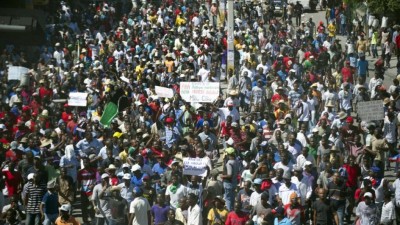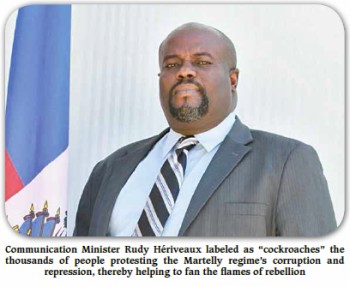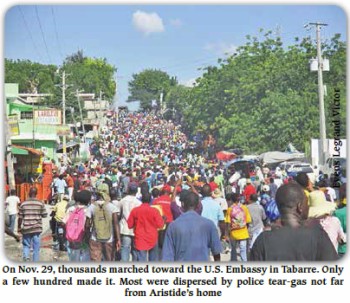Nationwide Uprising Gains Strength in Haiti
President Martelly Prepares to Jettison Prime Minister Lamothe

A nationwide uprising against the regime of business partners President Michel Martelly and Prime Minister Laurent Lamothe continued to gain steam this week with massive demonstrations in several major cities, including Port-au-Prince, Léogane, Petit Goâve, Cap-Haïtien, Fort-Liberté, Ouanaminthe, and Aux Cayes.
Feeling the protests’ heat, Martelly made a short televised national address on Nov. 28 to announce his formation of an “advisory commission” made up of 11 people whom he called “credible, honest, and trusted by society” to provide him “in eight days” with “a recommendation” on what path to take out of Haiti’s political imbroglio, saying that “the nation is divided, the problems are many, the problems are complicated.”
Martelly outlined five categories of recommendation which he had gleaned from “two months” of “consultations” with Haiti’s political actors: 1) remove Lamothe as Prime Minister; 2) dissolve Parliament on Jan. 12, 2015 when the terms of most senators and deputies expire; 3) change the composition of the Electoral Council; 4) form a Constituent Assembly to overhaul Haiti’s 1987 Constitution; and 5) extend Parliament’s life or put in place a council to function in place of Parliament.
Tellingly, Martelly did not include, or even mention in his address, the principal demand of the nationwide protests: that he and his prime minister immediately resign, ceding power to a State Council and Supreme Court judge, as happened when demonstration-beset-dictator Gen. Prosper Avril resigned in March 1990. The ensuing Dec. 16, 1990 election, carried out without the supervision of any occupying force like the current UN Mission to Stabilize Haiti (MINUSTAH), was among the fairest in Haitian history.
Many demonstrators are also calling for the remaining 6,600 soldiers of MINUSTAH to immediately leave Haiti.
Ironically, the “trusted” commission is made up of disgraced and discredited political figures, including Gérard Gourgue, the former “president” of a “parallel government” the opposition to President Jean-Bertrand Aristide concocted in 2001; Evans Paul, the archetypal scheming Haitian politician who was a leader in the 2004 coup; and Réginald Boulos, a leading political strongman championing the interests of Haiti’s tiny bourgeoisie.
 With typical humor, the Haitian people immediately dubbed Martelly’s proposal the “Baygon Commission,” referring to a popular insecticide in Haiti for killing cockroaches. In early November, Martelly’s Communications Minister, Rudy Hériveaux, a former leader in Aristide’s Lavalas Family party (FL), issued an editorial in which he wrote: “Carried away in a kind of destructive frenzy, these cockroaches are agitated into a disgusting folkloric display in the streets to try to attack the government.” He was referring to the tens of thousands now demonstrating and to the Haitian opposition generally.
With typical humor, the Haitian people immediately dubbed Martelly’s proposal the “Baygon Commission,” referring to a popular insecticide in Haiti for killing cockroaches. In early November, Martelly’s Communications Minister, Rudy Hériveaux, a former leader in Aristide’s Lavalas Family party (FL), issued an editorial in which he wrote: “Carried away in a kind of destructive frenzy, these cockroaches are agitated into a disgusting folkloric display in the streets to try to attack the government.” He was referring to the tens of thousands now demonstrating and to the Haitian opposition generally.
Such venomous comments and meaningless maneuvers by government officials have only stoked the flames of “Operation Burkina Faso,” as the movement is called, inspired by the October uprising that unseated President Blaise Compaoré in Ouagadougou. “Here are the cockroaches,” thousands of demonstrators now chant.
Following the giant demonstration on Nov. 25, equally large demonstrations swept the capital on Nov. 28 and Nov. 29, two dates with historic symbolism.
On Nov. 28, 1980, the Duvalier dictatorship brutally cracked down on its political opponents and the press following the election in the U.S. of right-wing President Ronald Reagan. In the reign of terror that followed, many anti-Duvalierist journalists, politicians, and activists were murdered, imprisoned, tortured, or exiled. Then on Nov. 28,1985 in Gonaïves, Duvalier’s soldiers and Tonton Macoutes gunned down three students: Mackenson Michel, Daniel Israel, and Jean Robert Cius. Outrage at these killings sparked the nationwide uprising that led to the fall of dictator Jean-Claude Duvalier on Feb. 7, 1986.
On Nov. 29, 1987, a neo-Duvalierist military junta, composed of Gens. Henry Namphy, and Williams Régala, backed by paramilitary chieftains like Claude Raymond, carried out an election day massacre, killing dozens of would-be voters, most bloodily and infamously at the Argentine School on Ruelle Vaillant in the capital.
Nov. 29, 1803 is also the day at Fort Dauphin in Haiti’s North that Haiti’s founding fathers first proclaimed independence, declaring at the time that “we have secured our rights, and we swear to yield to no power on earth.”
Inspired by their ancestors, on Nov. 29, 2013, thousands of demonstrators had tried to march on the U.S. Embassy in Tabarre, an action which was characterized as “Dessalines visits Uncle Sam.” But Haitian police brutally dispersed the protest with tear-gas before it reached the embassy.
The same thing happened this year. Haitian police met the chanting multitude with tear-gas, batons, and gunfire at the Fleuriot intersection, just a stone’s throw from the home were Aristide remains under virtual house arrest.
Nonetheless, a few hundred protestors managed to break through police lines and get to the embassy where Sen. Moïse Jean-Charles, the principal leader of the anti-Martelly and anti-occupation demonstrations, delivered a scathing speech.
“We were determined to demonstrate outside the embassy, and here we are,” he said. “We must fight, and through our determination, we have shown our ability to save our country from its current terrible situation.” Sen. Moïse was joined by other uprising leaders such as outspoken lawyer André Michel.
 Meanwhile, in the northeastern cities of Fort Liberté and Ouanaminthe near the border with the Dominican Republic, police wounded about 15 people with tear-gas and gunfire during a week of demonstrations. There were four deaths reported, including a three-month old infant and a 16-year-old boy. The people of the Northeast department are protesting against blackouts, while they claim that more than 12 megawatts of electricity remains unused at the Caracol Industrial Park, home to assembly factories. The residents of Fort-Liberté and Ouanaminthe want their electrical grids connected to Caracol’s power plant.
Meanwhile, in the northeastern cities of Fort Liberté and Ouanaminthe near the border with the Dominican Republic, police wounded about 15 people with tear-gas and gunfire during a week of demonstrations. There were four deaths reported, including a three-month old infant and a 16-year-old boy. The people of the Northeast department are protesting against blackouts, while they claim that more than 12 megawatts of electricity remains unused at the Caracol Industrial Park, home to assembly factories. The residents of Fort-Liberté and Ouanaminthe want their electrical grids connected to Caracol’s power plant.
In Ouanaminthe, demonstrations are demanding the dismissal of customs officials who harass with overcharges and blockages small merchants crossing over the border’s Massacre River into Dajabon. The demonstrations prevented 10 containers from getting to the Caracol Industrial Park. A contingent of 30 heavily armed policemen from the Brigade of Motorized Intervention (BIM) was dispatched to shepherd the containers in.
Beginning at 9 a.m. on Dec. 1, the townspeople of Cabaret, about 20 miles north of Port-au-Prince, blocked National Highway # 1 to demand electricity, drinking water, and a police outpost. Schools, banks, and markets were closed by the protest.
An official vehicle, determined to pass through the blockade, apparently fired on the crowd, reportedly killing two: a man known only as “Macintosh” and a woman who sold soda known as “Mabi.
As mayhem ensued, the police anti-riot unit, the Company for Intervention and Maintenance of Order (CIMO) arrived to suppress the crowd with tear-gas and water cannons.
“Water is life, electricity is development,” the crowd chanted. “We don’t want to continue to drink dirty water. If the police fire on us, the situation will deteriorate. Down with Martelly!”
Christel Thélusma, spokesman for the local organization MADIBA, condemned the government’s repression of peaceful demonstrations for basic needs.
“We do not want street lights, we want electricity in our homes so that our children can study their lessons,” he said. “We will not yield to the pressures of the police. Our demands are fair and justified. Martelly and Lamothe steal funds intended for development of the country, while we have no electricity, we have no drinking water. MINUSTAH’s cholera is killing us. This is our third demonstration, yet the authorities have never come to talk with the people.”
Similar demonstrations demanding electricity, drinking water, and Martelly’s resignation blocked National Highway #2 in Léogâne and Petit Goâve.
Opposition leaders have called for “Operation Burkina Faso” to continue with mass mobilizations on Dec. 5, 6, 11, 12, 13, 16, and 18.
Meanwhile, U.S. Secretary of State John Kerry is slated to visit Haiti on Dec. 12. In preparation for that meeting, U.S. Embassy officials invited six opposition leaders to a meeting on Dec. 2 at the headquarters of Fusion, Haiti’s principal social-democratic party.
According to highly placed sources in the opposition, the plan of the U.S. Embassy and the Martelly regime is to have Prime Minister Laurent Lamothe resign. This would kill two birds with one stone. First, it would make Martelly appear to have bowed to one of the opposition’s demands (although it is only the Lavalas Family which officially limits its demand to Lamothe’s resignation). Secondly, it would distance Lamothe, the U.S. Embassy’s darling, from Martelly, who is the focus of popular ire and has skeletons possibly about to spill out of his closet, including corruption, drug-trafficking, passport fraud, and maybe even murder.
Lamothe would then be free to concentrate on his presidential campaign for the end of 2015. According to the sources, former Prime Minister Jean Max Bellerive, or possibly his predecessor Michèle Pierre-Louis, would be brought in to “sell” a political deal to some opposition parties and most of the six senators resisting ratification of Martelly’s electoral law and electoral council, thereby isolating Sen. Moïse Jean-Charles.
However, Haiti is slippery ground, as the Kreyòl proverb says, and already things have not gone as planned. The Lavalas Family, perhaps the most important opposition party that needs to be part of any U.S. Embassy solution, did not attend the Dec. 2 meeting, outside of which several dozen demonstrators protested with signs like “USA=Bluff, Long live a Haiti without bluff!” (Kontra Pèp La also shunned sitting down with U.S. Ambassador Pamela White.)
In the days ahead, the U.S. and Haitian governments will keep trying to co-opt, divide, undermine, and threaten the Haitian opposition, as well as the larger social movement behind it, in an effort to keep Martelly and MINUSTAH in place. The challenge is for Martelly’s opposition to remain united and for the mass movement to sustain its mobilization until it has the same momentum as those which drove dictators from power in 1986 and 1990.

